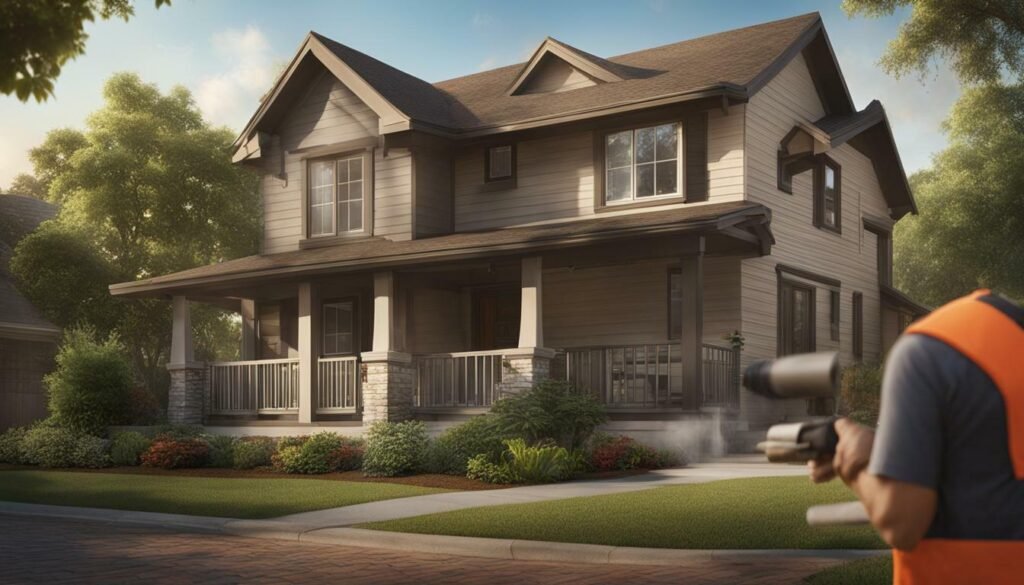Termite treatment is an essential step in protecting your home from these destructive pests. But how often should you opt for termite treatment?
Key Takeaways:
- Termite treatments can last from a few to 15 years, depending on the type of treatment and signs of current activity.
- Annual termite inspections are recommended as a preventive measure for homeowners.
- Previous termite infestations require proactive treatment to prevent reinfestation.
- Regular inspections and preventative measures can help keep termites away between treatments.
- Consulting with a pest control company is crucial to determine the optimal frequency for termite treatments.
Termite treatment is crucial in safeguarding your home and preventing costly damage caused by these destructive pests. However, determining how often you should undertake termite treatment can be a daunting task. Understanding the factors influencing treatment frequency and staying proactive in preventive measures are key to keeping termites at bay.
Factors to Consider for Termite Treatment Frequency
The frequency of termite treatment depends on several factors that should be taken into consideration to ensure the effectiveness of the treatment. Factual data shows that termite treatments can last anywhere from a few to 15 years, depending on the type of treatment and any signs of current activity. Therefore, it is important to evaluate these factors to determine the recommended termite treatment interval and the best timing for termite treatment.
Firstly, it is recommended to have your home inspected annually for termites as a preventive measure. Annual inspections help identify any potential termite activity early on, allowing for immediate action to be taken. This helps in minimizing the damage caused by termites and ensures the effectiveness of the treatment.
| Factors to Consider | Description |
|---|---|
| Previous Infestation | If your home has had a previous termite infestation, it is important to stay proactive and get re-treated in a timely manner. This helps to prevent a recurrence of infestation and maintain the structural integrity of your property. |
| Signs of Termite Activity | Keep an eye out for signs of termite activity such as mud tubes, discarded wings, or hollow-sounding wood. If these signs are observed, immediate treatment should be scheduled to eliminate the termites and prevent further damage. |
| Preventive Measures | Regular inspections and preventative measures can significantly reduce the likelihood of termite infestations between treatments. Simple steps like eliminating sources of standing water, keeping wood away from the home, and removing decaying trees and branches can help keep termites at bay. |
| Consulting with Pest Control Experts | To determine the optimal frequency and timing for termite treatments, it is best to consult with a pest control company. They have the expertise and knowledge to assess your specific situation and provide customized recommendations based on the factors mentioned above. |
By considering these factors and working closely with pest control professionals, you can ensure that your home receives the appropriate termite treatment frequency for long-term protection. Remember, prevention is key when it comes to termite control, and staying proactive is the best way to safeguard your property against these destructive pests.


Regular Termite Treatments: Prevention is Key
Regular termite treatments play a crucial role in preventing termite infestations and protecting your home from potential damage. Termites are silent invaders that can cause significant structural damage before you even realize they’re there. By scheduling regular termite treatments, you can proactively safeguard your home and avoid the costly repairs associated with termite damage.
Termite treatments can last anywhere from a few to 15 years, depending on the type of treatment and any signs of current activity. To ensure effective protection, it is recommended to have your home inspected annually for termites. These inspections can help detect termites in their early stages and allow for timely treatment, preventing them from establishing colonies and causing extensive harm.
For homeowners who have experienced a previous termite infestation, it is essential to stay proactive. Even if the infestation has been successfully eradicated, it doesn’t guarantee that termites won’t return. Getting re-treated in a timely manner is crucial to maintain long-term protection for your property. By staying vigilant and addressing any signs of termite activity promptly, you can minimize the risk of future infestations.
Besides regular inspections and treatments, there are additional preventative measures you can take to keep termites away between treatments. Eliminating sources of standing water, keeping wood away from the home’s foundation, and removing decaying trees and branches are simple yet effective steps that can discourage termites from infesting your property. By implementing these strategies, you create an environment that is less attractive to termites and reduce the likelihood of an infestation.
Key Takeaways:
- Regular termite treatments are essential for preventing termite infestations and protecting your home.
- Annual inspections can help detect termites early and allow for timely treatment.
- If your home has had a previous termite infestation, staying proactive and getting re-treated is important.
- Implement preventative measures, such as eliminating sources of standing water and removing decaying trees, to reduce the risk of infestation between treatments.
- Consulting with a pest control company can help determine the optimal frequency of termite treatments for your home.
| Pros of Regular Termite Treatments | Cons of Neglecting Termite Treatments |
|---|---|
| Prevents termite infestations | Risk of extensive structural damage |
| Protects the value of your property | Costly repairs and restoration |
| Ensures peace of mind for homeowners | Potential health risks from termite activity |
Maximizing Termite Treatment Effectiveness
To maximize the effectiveness of termite treatments, it is important to follow certain practices and guidelines. Factual data shows that termite treatments can last anywhere from a few to 15 years, depending on the type of treatment and any signs of current activity. However, it is recommended to have your home inspected annually for termites as a preventive measure.
If your home has had a previous termite infestation, it is crucial to stay proactive and get re-treated in a timely manner. Regular inspections and preventative measures play a vital role in keeping termites away between treatments. For instance, eliminating sources of standing water, keeping wood away from the home, and removing decaying trees and branches can significantly reduce the risk of termite infestations.
Consulting with a reputable pest control company is essential to determine the optimal frequency of termite treatments for your home. They will assess your specific situation, taking into account factors such as the type of treatment used, the local termite population, and the construction of your property. Their expertise will help ensure that you are on the right track to a termite-free home.


Important Tips to Enhance Termite Treatment Efficiency:
- Seal cracks and crevices in your home’s foundation, as these can serve as entry points for termites.
- Address moisture issues, as termites are attracted to damp environments. Fix any leaks and ensure proper drainage around your property.
- Maintain a clearance between soil and wooden structures, such as decks or fences, to prevent direct contact between termites and your home.
- Store firewood away from your home, as it can attract termites and provide an easy pathway into your property.
- Regularly inspect wooden structures, such as window frames and door frames, for any signs of termite activity.
By following these practices and guidelines, you can maximize the effectiveness of your termite treatments and minimize the risk of termite infestations in your home.
Signs of Termite Activity: When to Schedule Treatment
Recognizing the signs of termite activity is crucial in determining when to schedule termite treatment. By being vigilant and observant, you can catch the early warning signs of a termite infestation and take prompt action to protect your home.
One common sign that termites may be present is the presence of discarded wings. Termites swarm to find new areas to establish colonies, and once they have found a suitable location, they shed their wings. If you come across a pile of wings near the entrances of your home or on windowsills, it is likely an indication that termites are nearby.
Damage to wooden structures is another telling sign of termite activity. Termites feed on wood, and over time, their feeding can weaken the structure, causing it to become hollow or brittle. Look out for sagging floors, loose tiles, or hollow-sounding wood when tapped, as these are signs of termite damage.
Termite mud tubes are another clear indication of an infestation. These tubes, which are made from soil, wood particles, and termite saliva, act as protective tunnels for termites to move around. If you notice mud tubes along the foundation of your home or on walls, it’s time to schedule termite treatment.
| Signs of Termite Activity | Description |
|---|---|
| Discarded Wings | Termites shed their wings after swarming; finding piles of wings is a strong indication of termite presence. |
| Wood Damage | Damage to wooden structures such as sagging floors, loose tiles, or hollow-sounding wood suggests termite infestation. |
| Mud Tubes | Termite mud tubes, made of soil, wood particles, and termite saliva, provide shelter and transportation for termites. |


If you notice any of these signs, it is important to schedule termite treatment as soon as possible. Termites can cause significant damage to your home if left untreated, so taking immediate action is crucial to minimize the potential impact.
Remember, prevention is always better than cure when it comes to termite control. Regular inspections and preventative measures, along with timely treatments, can help keep termites at bay and safeguard your home from costly damage.
Consulting with a pest control company will provide you with expert advice on the optimal timing and frequency of termite treatments for your specific situation. Their knowledge and experience will ensure that your home remains protected from termites for years to come.
Duration of Termite Treatments
The duration of termite treatments can vary based on the type of treatment and the presence of any ongoing termite activity. Depending on the severity of the infestation, termite treatments can take anywhere from a few days to several weeks to complete. It is important to note that complete eradication of termites may require multiple treatments over a period of time.
For example, if your home is being treated with liquid termiticides, the application process typically takes a few hours to a few days. However, the effects of the treatment may last for several years, providing long-term protection against termites.
If your home requires a more extensive treatment, such as termite baiting or fumigation, the process may take several weeks to complete. These treatments target termites at their source and can eliminate the entire colony, ensuring long-lasting protection for your home.


It is important to work with a professional pest control company to determine the most appropriate treatment for your specific situation. They will assess the extent of the infestation, the type of termites present, and any ongoing termite activity to customize a treatment plan that addresses your needs.
Remember, the duration of termite treatments may vary depending on factors such as the size of your home, the severity of the infestation, and the type of treatment used. Regular inspections and maintenance are crucial to monitor for any signs of termite activity and ensure the effectiveness of your treatment plan.
Summary:
– The duration of termite treatments can vary based on the type of treatment and the presence of any ongoing termite activity.
– Liquid termiticides provide long-term protection, with effects lasting for several years.
– More extensive treatments like termite baiting or fumigation may take several weeks to complete but can eliminate the entire termite colony.
– Work with a professional pest control company to determine the most appropriate treatment for your specific situation.
– Regular inspections and maintenance are essential to monitor for signs of termite activity and ensure the effectiveness of your treatment plan.
| Termite Treatment | Duration |
|---|---|
| Liquid Termiticides | Several hours to several days |
| Termite Baiting | Several weeks |
| Fumigation | Several weeks |
Previous Infestations: Stay Proactive
If your home has had a previous termite infestation, it is crucial to stay proactive and maintain a regular treatment schedule. Termites can cause extensive damage to your property, and even a single infestation should be taken as a warning sign. To ensure your home remains protected, it is important to continue treating for termites on a regular basis.
Regular inspections play a key role in detecting any signs of termite activity early on. By scheduling annual termite inspections, you can identify potential issues before they become major problems. These inspections allow trained professionals to assess your property and determine the frequency of termite treatments required.
In addition to regular inspections and treatments, there are several preventative measures you can take to reduce the risk of termite infestations. Eliminating sources of standing water, such as leaky pipes or clogged gutters, can help deter termites from your property. Keeping firewood and other wooden materials away from your home’s foundation is also important, as termites are attracted to wood.


Furthermore, removing decaying trees and branches from your yard can significantly reduce the likelihood of termites finding their way into your home. By creating a termite-unfriendly environment, you can help protect your property and maintain the integrity of your home.
Summary:
- If your home has had a previous termite infestation, it is crucial to stay proactive and maintain a regular treatment schedule.
- Schedule annual termite inspections to detect any signs of termite activity early on.
- Take preventative measures such as eliminating sources of standing water, keeping wood away from your home, and removing decaying trees and branches.
- Consult with a pest control company to determine the optimal frequency of termite treatments for your home.
By staying proactive and implementing these preventative measures, you can minimize the risk of future termite infestations and protect your home from costly damage.
Annual Inspections: A Preventive Measure
Annual inspections are a vital step in identifying early signs of termite activity and determining the need for treatment. By scheduling regular inspections, you can stay proactive in protecting your home from these damaging pests. During an inspection, a qualified pest control professional will thoroughly examine your property for any signs of termite infestation, including mud tubes, discarded wings, and wood damage.
These inspections are especially important if your home has previously experienced a termite infestation. Even if you have already undergone treatment, it is crucial to continue monitoring for any signs of termite activity. Termite treatments can last anywhere from a few to 15 years, depending on the type of treatment and any signs of current activity. Regular inspections help ensure that any new termite activity is detected early, allowing for prompt treatment and minimizing potential damage.
In addition to identifying termite activity, annual inspections provide an opportunity to assess the effectiveness of previous treatments and make any necessary adjustments. The pest control professional can also offer advice on preventative measures to keep termites at bay between treatments. These measures may include eliminating sources of standing water, keeping wood away from the home, and removing decaying trees and branches.
Consulting with a pest control company is the best way to determine how often your home should be treated for termites. The frequency of termite treatments depends on various factors, such as the region you live in, the construction materials of your home, and the presence of nearby termite colonies. A pest control expert will assess these factors and recommend a treatment schedule tailored to your specific needs.
| Signs of Termite Activity | Recommended Treatment Frequency |
|---|---|
| Visible mud tubes or tunnels | Immediate treatment |
| Wood damage | Immediate treatment |
| Discarded termite wings | Immediate treatment |
| No visible signs, but annual inspection reveals termite activity | Treatment as advised by the pest control professional |
| No visible signs or active termite activity | Regular annual inspections and preventative measures |
Takeaway
Regular annual inspections are essential for maintaining a termite-free home. By identifying early signs of termite activity and scheduling timely treatments, you can protect your property from costly damage. Don’t forget to consult with a pest control professional to determine the optimal treatment frequency for your specific situation. Together, these efforts will help keep termites at bay and ensure the long-term protection of your home.


Preventative Measures: Keeping Termites at Bay
Alongside regular termite treatments, adopting preventive measures can help keep termites away from your home. By implementing these measures, you can create an environment that is less attractive to termites, reducing the likelihood of infestations between treatments. Here are some effective strategies:
- Eliminate sources of standing water around your property, as termites are attracted to moisture. Make sure to fix any leaky faucets or pipes and ensure proper drainage around your home.
- Keep firewood and other wooden materials away from the perimeter of your house. If possible, store them at least 20 feet away from your home to minimize the risk of termite access.
- Remove decaying trees, stumps, and branches from your yard. These can serve as food sources for termites and attract them to your property.
- Seal any cracks or gaps in your home’s foundation, walls, and roof. Termites can easily squeeze through small openings, so it’s important to seal these entry points to keep them out.
- Regularly inspect and maintain your gutters and downspouts to ensure they are functioning properly. Clogged or damaged gutters can lead to water pooling near your home, which can attract termites.
Remember, prevention is key when it comes to termite control. By taking these proactive measures, you can significantly reduce the risk of termite infestations and protect your home.
Expert Tip: Termite-Resistant Building Materials
When constructing or renovating your home, consider using termite-resistant building materials. These materials are specially treated or naturally resistant to termites, providing an additional layer of protection against infestations. Some common termite-resistant materials include treated lumber, concrete, steel, and certain types of wood with natural termite repellent properties. Consult with your contractor or architect to explore these options and determine the best choices for your project.
By combining regular termite treatments with these preventative measures, you can effectively keep termites at bay and safeguard your home from the damage they can cause.
| Preventative Measure | Frequency | Description |
|---|---|---|
| Eliminate standing water | As needed | Regularly check for and address any sources of standing water to reduce moisture attraction for termites. |
| Keep wood away from home | Ongoing | Store firewood and other wooden materials away from the perimeter of your house to minimize termite access. |
| Remove decaying trees and branches | As needed | Regularly inspect and remove any decaying trees, stumps, or branches that can serve as termite food sources. |
| Seal cracks and gaps | Ongoing | Properly seal any cracks or gaps in your home’s foundation, walls, and roof to prevent termite entry. |
| Maintain gutters and downspouts | Regularly | Regularly inspect and maintain your gutters and downspouts to ensure proper water drainage. |
Implementing these preventative measures, in addition to regular termite treatments, will help protect your home from costly termite damage and give you peace of mind.


Consulting with Pest Control Experts
To determine the recommended interval and best timing for termite treatments, it is advisable to seek guidance from experienced pest control experts. These professionals have in-depth knowledge of termite behavior and treatment options, allowing them to provide tailored recommendations for your specific situation. By consulting with pest control experts, you can ensure that your home receives the necessary protection against termites.
Pest control experts will conduct a thorough inspection of your property to assess the extent of any termite infestations or damage. Based on their findings, they will recommend an appropriate treatment interval to address the current infestation and prevent future ones. This interval can vary depending on factors such as the severity of the infestation, the type of treatment used, and the geographic location of your home.
In addition to determining the treatment interval, pest control experts can also advise on the best timing for termite treatments. They understand the life cycles and behavior patterns of termites, allowing them to identify the most effective time to apply treatments for maximum impact. By timing the treatments strategically, you can disrupt termite colonies and minimize the risk of reinfestation.
Remember, termites can cause significant damage to your home if left untreated. By seeking guidance from pest control experts, you can ensure that your termite treatments are conducted at the right interval and timing, providing long-lasting protection for your home and peace of mind for you and your family.


Long-Term Termite Treatment Planning
Long-term termite treatment planning involves considering the specific needs of your home and implementing a strategic approach to safeguard against termite infestations. To ensure the long-term protection of your property, it is important to follow a comprehensive treatment plan tailored to your unique circumstances.
Start by scheduling regular inspections with a reputable pest control company. Annual termite inspections are recommended as a preventive measure to catch any signs of termite activity early on. These inspections can help identify any vulnerabilities in your home and determine the appropriate treatment frequency.
During the inspection, the pest control experts will assess the condition of your property, looking for conducive conditions that may attract termites. This may include factors such as moisture buildup, wood-to-soil contact, or the presence of termite food sources. Based on their evaluation, they will recommend a treatment plan that best suits your needs.
In addition to regular inspections, implementing preventative measures can help reduce the likelihood of termite infestations and prolong the effectiveness of treatments. Simple steps such as eliminating sources of standing water, keeping firewood away from the home, and removing decaying trees and branches can go a long way in deterring termites.


| Long-Term Termite Treatment Tips |
|---|
| 1. Maintain proper drainage around your home to prevent moisture buildup. |
| 2. Use treated wood or alternative materials for construction to reduce the risk of termite infestations. |
| 3. Keep vegetation trimmed and avoid allowing plants to touch the exterior of your home. |
| 4. Store firewood at least 20 feet away from your home and elevate it off the ground. |
| 5. Seal any cracks or gaps in your home’s foundation or exterior walls to prevent termite entry. |
Consulting with pest control experts is essential for developing a long-term termite treatment plan tailored to your specific situation. They have the knowledge and expertise to recommend the optimal treatment frequency and strategies to keep your home protected. By following their guidance and incorporating preventative measures, you can safeguard your property against termite infestations for years to come.
Conclusion
Regular termite treatments, based on factors such as previous infestations and annual inspections, are essential in maintaining a termite-free home. Termite treatments can last anywhere from a few to 15 years, depending on the type of treatment and any signs of current activity. To ensure the effectiveness of your termite treatments, it is recommended to have your home inspected annually for termites as a preventive measure.
If your home has had a previous termite infestation, it is important to stay proactive and get re-treated in a timely manner. Regular inspections and preventative measures can help keep termites away between treatments. For example, eliminating sources of standing water, keeping wood away from the home, and removing decaying trees and branches are all effective strategies to deter termites from infesting your property.
Consulting with a pest control company is highly recommended to determine how often your home should be treated for termites. They have the expertise to assess your specific situation and provide customized treatment plans. By following their recommendations, you can maximize the effectiveness of termite treatments and ensure long-term protection for your property.
Remember, prevention is key when it comes to termites. Regular termite treatments, combined with proactive measures and professional guidance, will help you maintain a termite-free home and protect your investment for years to come.
FAQ
Q: How often should termite treatments be done?
A: Termite treatments can last anywhere from a few to 15 years, depending on the type of treatment and any signs of current activity. It is recommended to have your home inspected annually for termites as a preventive measure.
Q: What factors should I consider for termite treatment frequency?
A: Factors such as the type of treatment, signs of termite activity, and previous infestations should be considered when determining the frequency of termite treatments. Consulting with pest control experts can help determine the recommended termite treatment interval.
Q: How can regular termite treatments prevent infestations?
A: Regular termite treatments are essential as a preventive measure to keep termites away from your home. They help create a barrier of protection and reduce the likelihood of infestations.
Q: What can I do to maximize termite treatment effectiveness?
A: To maximize the effectiveness of termite treatments, it is important to eliminate sources of standing water, keep wood away from your home, and remove decaying trees and branches. These proactive measures can help keep termites away between treatments.
Q: When should I schedule termite treatment?
A: If you notice signs of termite activity, such as mud tubes, swarming termites, or wood damage, it is crucial to schedule treatment immediately. Regular inspections and vigilance can help detect termite activity early.
Q: How long do termite treatments typically last?
A: Termite treatments can last for different periods of time, ranging from a few to 15 years. The duration depends on the treatment type and any signs of current termite activity.
Q: Why is it important to stay proactive after a previous termite infestation?
A: Homes that have had previous termite infestations are at higher risk of future infestations. It is important to stay proactive and get re-treated in a timely manner to maintain the protection of your home.
Q: How often should I have my home inspected for termites?
A: Annual inspections are recommended as a preventive measure for termite control. They help identify any signs of termite activity early, allowing for timely treatment.
Q: What preventative measures can I take to keep termites at bay?
A: To reduce the likelihood of termite infestations between treatments, it is important to eliminate sources of standing water, keep wood away from your home’s foundation, and remove decaying trees and branches. These measures can help deter termites.
Q: Should I consult with pest control experts for termite treatment frequency?
A: Consulting with pest control professionals is recommended to determine the optimal frequency and timing for termite treatments. They have the expertise to assess your specific situation and provide personalized recommendations.
Q: How can long-term termite treatment planning help protect my home?
A: Long-term termite treatment planning involves scheduling regular treatments and inspections to ensure continuous protection for your home. This proactive approach is crucial in preventing termite infestations.
Source Links
- https://www.myheronhome.com/pest/termites/prevention/how-often-should-my-home-be-treated-for-termites/
- https://www.loyalpest.com/termites/treatment/how-often-should-my-home-be-treated-for-termites/
- https://www.flapest.com/termites/treatment/how-often-should-my-home-be-treated-for-termites/
Your Expert in Animal Control and Extermination. Trust our experience for humane, effective pest management, protecting your property and ensuring peace of mind with Michael S.





